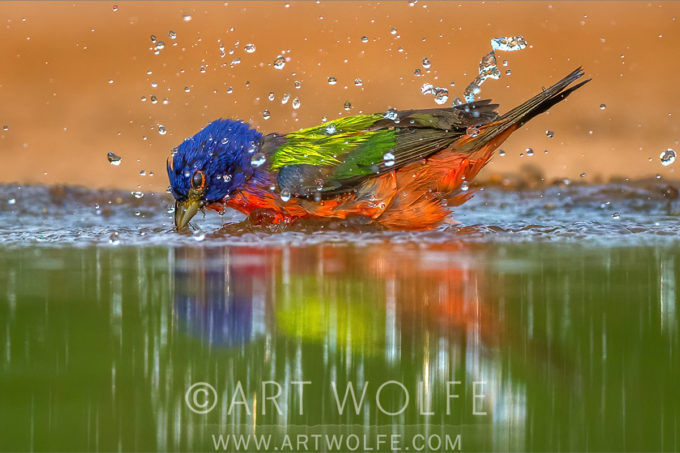#TechniqueTuesday – Freezing the Action & High ISO Cleanup
Happy Technique Tuesday!

If you’ve been paying attention to the blog or caught last week’s livestream, you already know I’m keeping myself occupied lately working on a new series of educational videos releasing very soon. If you follow me you know that I’m an artist first and a technician second – I learn to use technology as I need it, but unlike many photographers my background lies in fine art.
That being said, my upcoming lecture series will touch on many of the technical aspects of photography as well, for example using a high shutter speed to capture water droplets around the high-speed movements of this small painted bunting.
Freezing the action here requires a fast shutter speed – in this case I’ve chosen 1/6400th of a second. I’ve achieved my goal – the droplets and the bunting are sharp! However one problem you may run into depending on the available lighting is the high ISO required to get enough light from such a brief exposure. In this case my ISO was bumped all the way up to 5000 – well beyond what most photographers are comfortable with.
Personally I have always pushed my use of ISO; if the photo truly requires a high number to get the effect and freeze the action like I want it to, I am okay introducing a bit of noise. Much of that can be removed later in post. As an example, here is a close-up of this image with one side using Topaz Denoise AI, and the other the original image:

As you can see, Topaz does a great job of removing much of the noise in the image while retaining details. I highly recommend that regardless of the software you use to remove noise, that this is your first step in your edit. As you tweak levels, colors, and other attributes of your image, they may overly enhance the noise making it harder to retroactively remove. After you remove the noise, you can then go back and re-introduce some sharpening where needed, selectively avoiding areas with large swaths of color that will just end up looking noisy.
That will have to be a lesson for another day – enjoy your week, stay safe and healthy!


Thank you for this. I am testing Topaz Denoise. In a future lesson will you discuss workflow from camera raw, raw processing (exposure, white balance, et al), Denoise and Sharpening including files formats at various stages of the workflow?
A big YES to Topaz’s DeNoise. I downloaded it to try and couldn’t believe the excellent job it did on a few photos I really liked but were noisy. I also used the included AI Clear. My bird photo was just so ever out of focus and it cleaned it up well enough to be useable. I bought the program and think it’s the best software for its purpose.
Its amazing what software can do these days. I only use Topaz for sharpening. I use Dxo optics pure raw for iso denoising. Definitely shooting a lot faster these days and re editing old raw files.